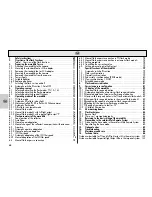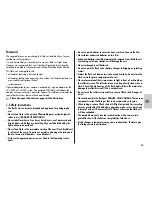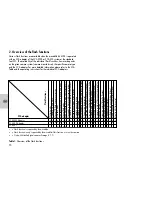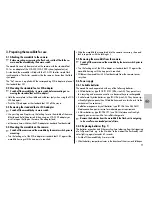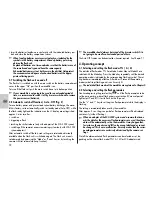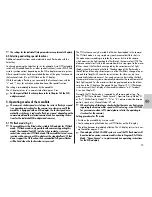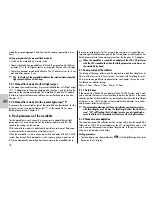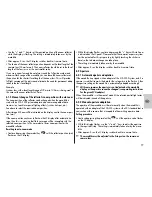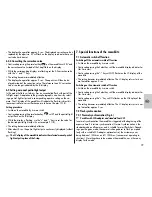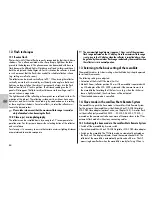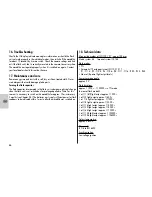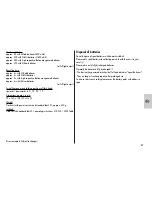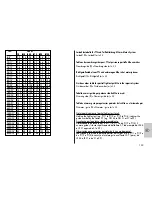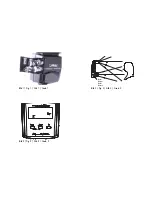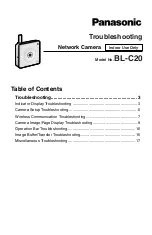
78
ķ
6.3 ISO film speed
6.3.1 Automatic adaptation of the ISO film speed
If the mecablitz is equipped with an adapter of the SCA 3002 system, and is
used in conjunction with a camera that is capable of transmitting ISO film
speed data to the flash unit, then the ISO speed on the mecablitz will auto-
matically be adapted accordingly.
With some camera models the ISO speed will not be indicated on the
mecablitz LC display or the ISO value cannot be changed (see ope-
rating instructions for the given SCA adapter).
6.3.2 Manual adaptation of the ISO film speed
The ISO speed must be set manually on the mecablitz when the mecablitz is
used in conjunction with an SCA 300 system adapter or with the 301 stand-
ard foot, or if the camera cannot transmit ISO film speed data.
Setting procedure
• Continue depressing the preselect key
until the ISO value flashes on
the LC display.
• While this value flashes, use the “+” and “-” keys to modify the ISO speed
as required. This setting is immediately taken over by the mecablitz.
• After approx. 5 sec. the display switches back to its normal state.
The mecablitz must be adjusted to the ISO value set on the camera.
Observe the ISO speed of the film loaded in the camera.
6.4 Manual flash exposure correction
The automatic TTL flash expossure system of most cameras is matched to a
25 % degree of light reflection by the subject (average amount of light reflec-
ted by subjects shot with flash). Consequently, a dark background that ab-
sorbs a great deal of light, or a bright background that reflects a great deal
of light, can result in under- or overexposure, respectively.
To offset this effect a manual correction value can be set to adapt the auto-
matic flash exposure to the photographic situation. The correction value
depends on the contrast prevailing between subject and background.
☞
☞
A dark subject in front of a bright : Positive correction value (approx.
1 to 2 f-stops). A light subject in front of a dark background: Negative
correction value (approx. -1 to -2 f–stops). If a correction value is set
the maximum flash range indicated on the mecablitz LC display may
change to match the given correction value (depending on the SCA
adapter and camera model).
Do not forget to cancel manual flash exposure correction after picture shoot-
ing.
6.4.1 Manual flash exposure correction in TTL flash mode
The mecablitz must be fitted with an SCA 3002 system adapter and the TTL
flash mode must be selected on the mecablitz.
The camera must support the setting of a manual correction value on the
mecablitz. With some cameras a manual correction value for TTL flash expo-
sure can only be set on the camera body. In such an event, a corresponding
setting cannot be made on the mecablitz or remains ineffective (see operat-
ing instructions for the given SCA adapter and camera).
Exposure correction by changing the lens aperture is not possible
because the camera’s automatic exposure system will regard the
changed aperture as a normal working aperture.
6.4.2 Manual flash exposure correction in automatic flash mode A
The mecablitz must be fitted with an SCA adapter or the 301 standard foot.
The automatic flash mode A must be set on the mecablitz.
6.4.3 Setting procedure
• Set the TTL flash mode or the automatic flash mode A on the mecablitz.
• Continue depressing the preselect key
on the mecablitz until EV and
the correction value (instead of the f-stop) flash on the display.
• While the corresponding displays are flashing, use the “+” and “-” keys to set
the required correction value (in this example the correction value = -0.7 f-stop).
• The setting becomes immediately effective.
☞
☞


